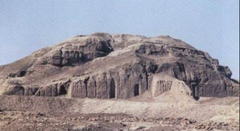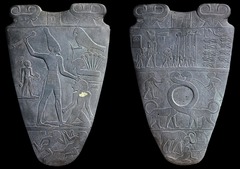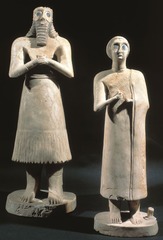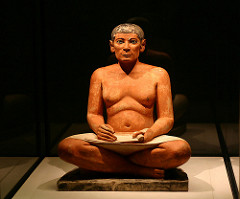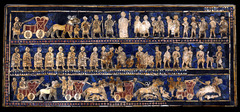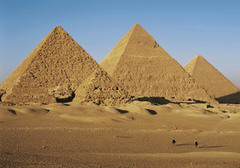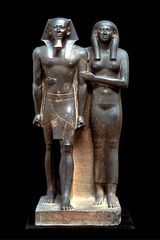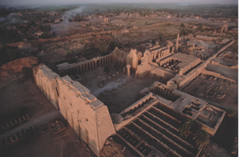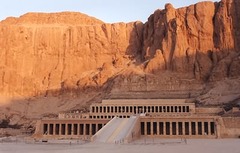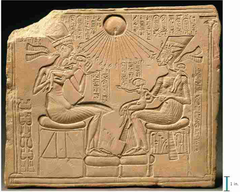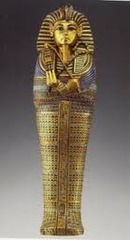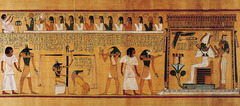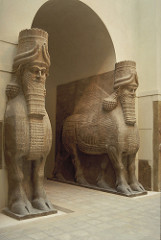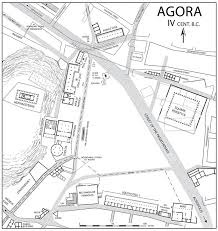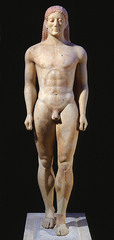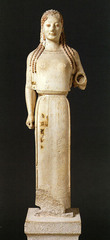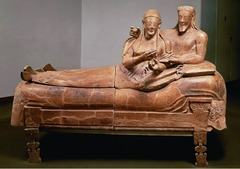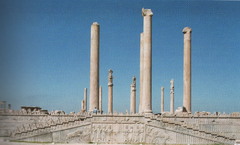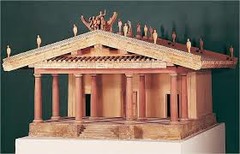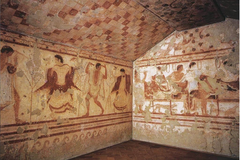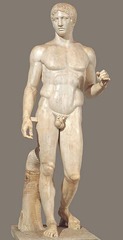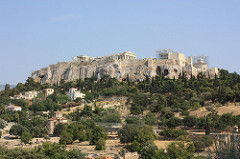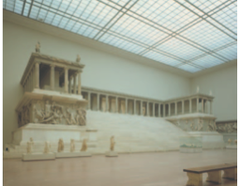White Temple and Ziggurat, Uruk
FORM: Ziggurat is mud-brick
FUNCTION: The Ziggurat was used to symbolize the significance of the god/goddess honored there. The Temple is theorized to honor the sky god, "Anu."
CONTEXT: Modern-day Iraq; 3200-3000 BC. The oldest surviving Ziggurat. Sumerians.
CONTENT: The White Temple sits atop the Ziggurat, as a place for rituals in which a select few would speak to the Gods. The Ziggurat stood at the center of the city, representing its religiousness.
Palette of King Narmer
FORM: Siltstone
FUNCTION: Palettes are typically used for grinding and mixing in order to make cosmetics. Due to the decoration of this piece and the place it was found, it was thought to be used for ceremonial purposes during the worship of a god.
CONTEXT: 31st century BC; Egypt. Discovered among other ceremonial artifacts in a temple dedicated to the falcon god Horus.
CONTENT: King Narmer is shown on the palette, and his name is written in one of the earliest found examples of hieroglyphic inscription. The god Horus is also thought to have been shown here, in the form of a falcon with a human arm. The palette is thought to have represented the unification of Egypt.
Statues of Votive Figures
FORM: Gypsum and Limestone
FUNCTION: To serve as representations of worshippers, permanently praying to their god.
CONTEXT: 2900-2600 BCE; Mesopotamia. Votive figures such as these were popular, and these particular pieces were found among 12.
CONTENT: The worshippers display clasped hands and wide eyes. As this style of sculpting was distinct from more realistic sculpting at the time, these are thought to be intentionally abstract figures.
Seated Scribe
FORM: Painted Limestone
FUNCTION: Portrait of a wealthy scribe meant for funerary purposes- to be put in a tomb.
CONTEXT: 2620-2500 BCE; Egypt.
CONTENT: The sculpture pictures a topless man sitting cross-legged, writing on papyrus with what once was a pen. The man is presumably middle-aged and wealthy/important, due to his bodily structure and his ability to write (for the state).
Standard of Ur
FORM: Wood, shell, lapis lazuli, limestone
FUNCTION: Not entirely known, but theorized to have been carried on a pole as a standard or to have been a soundbox for an instrument
CONTEXT: 2600-2400 BCE; Modern-day Iraq. Found in one of the largest graves at the royal cemeteries of Ur.
CONTENT: Displays two main panels: one depicting "War": a Sumerian army trampling their enemies, displaying some of them naked to their spear-wielding king. The other panel is "peace": displaying people bringing offerings to a banquet.
Great Pyramids of Giza
FORM: Limestone
FUNCTION: Served as mortuary complexes for three royals- Khufu, Khafre, and Menkaure.
CONTEXT: 2550-2490 BCE; Egypt.
CONTENT: Three pyramids were built. The Great Pyramid (of Khufu) is the largest, although Khafre's appears taller. Mekaure's pyramid is the smallest, although it has preserved many sculptures within.
King Menkaure and Queen
FORM: Greywacke
FUNCTION: To ensure "rebirth" of the king Menkaure in the afterlife.
CONTEXT: 2490-2472 B.C.E; Egypt.
CONTENT: Menkaure is shown in an idealized state- youthful, attractive in stature- his head turned slightly to the right. The queen (sometimes suspected to be his mother) is fully frontal, topless and also idealized. Both figures have their left foot forward and are around the same height- perhaps implying that the kind and queen were thought of as equals.
The Code Stele of Hammurabi
FORM: Basalt
FUNCTION: A text describing laws(typically in relation to crime and punishment) in a universally understood manner
CONTEXT: 1792- 1750 BCE; Babylon (modern Iran)
CONTENT: Codes of law inscribed in Akkadian using cuneiform script. King Hammurabi is depicted similarly to a savior of the people who has created a great empire.
Temple of Amun-Re and the Hypostyle Hall
FORM: Sandstone and mud-brick
FUNCTION: The temple served as both a place of worship to Amun-Re and as a home for the God on Earth.
CONTEXT: Temple 1550 BCE; hall 1250 BCE. Egypt.
CONTENT: The temple served as a model of the cosmos in design and a place of worship and home for Amun-Re. The further one went into the temple, the more restricted access became. The Hypostyle Hall (a space with a roof held up by columns) would be restricted to most, but contained 134+ columns and allowed for clerestory lighting.
Mortuary Temple of Hatshepsut
FORM: Sandstone carved into a rock cliff, red granite
FUNCTION: A funerary shrine for Hatshepsut and a temple for the god Amun-Re.
CONTEXT: 1473-1458 BCE; Egypt.
CONTENT: Sculptures of the pharaoh Hatshepsut line the temple, in which she is portrayed visually as a male- with little feminine features and traditionally male clothing. Her facial features and inscriptions of her name do, however, describe her as female. Once a year a statue of (portraying the embodiment of) Amun-Re would be carried to the temple, and many of Hatshepsut's sculptures were posed with her kneeling and holding offerings in reference to said god.
Akhenaten, Nefertiti, and Three Daughters
FORM: Limestone
FUNCTION: As an alter to Akhenaten and Nefertiti, the sole people who can contact Aten- the supreme deity, the sun God.
CONTEXT: 1353-1335 BCE; Egypt.
CONTENT: Akhenaten changed Egypt's religion to worship Aten, not Amun-Re. Aten is represented by a sun in this picture, giving life to solely Akhenaten and Nefertiti. The queen and king are portrayed on similar levels, ruling together, as they hold their three daughters. There is a clear stylistic abstractness- in which the anatomy of the human figures draws upon curved lines in contrast to straight lines which predominated in much of Egyptian art.
Tutankhamun's tomb
FORM: Gold with inlay of enamel and stones
FUNCTION: The innermost of three coffins that contained Tutankhamun's mummy was supposed to signify the body he would take into the afterlife.
CONTEXT: 1323 BCE; Egypt.
CONTENT: The young Tut is portrayed in the traditional nemes headdress and false beard. He is shown as a warrior, as depicted on panels painted onto his chest, despite his age.
Last Judgement of Hu-Nefer (Book of the Dead)
FORM: Painted papyrus scroll
FUNCTION: To assure Hu-Nefer's existence in the afterlife
CONTEXT: 1275 BCE; Egypt. A page from the "Book of the Dead" excavated from Hu-Nefer's tomb.
CONTENT: Hu-Nefer, a scribe of presumably well-standing, is portrayed in this book. On this page, Anubis brings Hu-Nefer to the judgement scales. His heart is being weighed against a feather- if the heart did not balance, he would be condemned to non-existence and consumption by a "devourer." Hu-Nefer is implied to pass this judgement as he is shown being brought to Osiris.
Lamassu from the citadel of Sargon II, Dur Sharrukin
FORM: Alabaster
FUNCTION: To guard the citadel of Sargon II, intimidating visitors and displaying the King's power
CONTEXT: 720-705 BCE; Modern-day Iraq. Carved at the height of Assyrians.
CONTENT: The Lamassu are portrayed as beasts with wings, but heads of men. They stand as symbols of power and authority of the King and as guardians of the citadel.
Athenian Agora
FORM:
FUNCTION: To serve as the center for business, education, culture, government, religion, and social life in Athens.
CONTEXT: 600 BCE-150 CE.; Greece
CONTENT: The agora was full of building's contributing to the cities economic, political, and social life- there were law courts, archives, and a council chamber; various marketplaces/shops; sacred areas; sculptures and monuments; and libraries and concert halls. Philosophers (such as Socrates) would walk through the agora and ask shopgoers uncomfortable (but insightful) questions.
Anavysos Kouros
FORM: Marble
FUNCTION: A grave marker for a young man who died in war.
CONTEXT: 530 BCE; Greece
CONTENT: The "Kouros" was a sculpture of a youth male. The youth here is idealized, but more lifelike and less blocky than older kouros. He is portrayed with strength, with one foot forward, and as a warrior who has been slain by Ares during war.
Peplos Kore from the Acropolis
FORM: Marble
FUNCTION: Either an offering to a goddess (Artemis/Athena) or a sculpture representing Artemis/Athena.
CONTEXT: 530 BCE; Greece.
CONTENT: "Peplos" is an ancient Greek costume. A "Kore" is a counterpart to the Kouros, but with a clothed woman. She wears an archaic smile, and is thought to represent ideal femininity. She is believed to either be an offering to a God, or a god herself- perhaps Athena or Artemis- as it is unknown if she was previously holding a bow that had been lost.
Sarcophagus of the Spouses
FORM: Terra cotta
FUNCTION: Thought to be a sarcophagus or an urn for the ashes of the couple
CONTEXT: 520 BCE; Etruscan tomb.
CONTENT: The couple are depicted in a lifelike manner, in contrast to the stiffness portrayed in similar sculptures. The arms of the couples are outstretched, perhaps to hold items relating to a banquet.
Audience Hall (apadana) of Darius and Xerxes
FORM: Limestone
FUNCTION: To be used for receptions for Persian kings
CONTEXT: 520- 465 BCE; Persia/Modern-day Iran
CONTENT: The hall contained 72 columns and two massive stairways. Carvings leading to the reception hall depicted people from different cultures giving offerings to the Persian king.
Temple of Minerva and the sculpture of Apollo
FORM: Temple is wood, mud brick, or tufa; Sculpture is terra cotta
FUNCTION: As a worshipping grounds for the goddess Minerva.
CONTEXT: 510-500 BCE; Etruscan.
CONTENT: The sculpture of Apollo stands at the peak of the temple roof.
Tomb of the Triclinium
FORM: Tufa and fresco
FUNCTION: To serve as a chamber tomb; it is suspected that Etruscan funeral traditions were festive and the banquet portrayed here symbolizes a final meal with the deceased as they move to the afterlife.
CONTEXT: 480-470 BCE; Etruscan.
CONTENT: The tomb is a single chamber with decorations lining the walls in fresco. A banquet is portrayed in these decorations, with both male and female attendees (presumably elites) dining. Musicians and dancers are also drawn, as well as allusions to games that would be played alongside funerals.
Niobides Krater
FORM: Clay, using the red-figure technique
FUNCTION: Possible decoration of ceremonial reasons as it displays gods/goddesses
CONTEXT: 460-450 BCE; Greece
CONTENT: One side of the vase displays Apollo and Artemis destroying Niobe's children with arrows; the other side displays Heracles and Athena and others in arms
Doryphoros (Spear Bearer)
FORM: Marble copy of Greek bronze statue (as bronze was often melted to make weaponry, the original has likely not survived)
FUNCTION: Sculpture displaying idealized bodily proportions
CONTEXT: 450-440 BCE; Roman copy of Greek statue
CONTENT: The athlete depicted would've been carrying a spear (that is now lost). He is shown nude, with youthful features and bodily proportions said to represent the Greek balance of harmony and beauty.
Acropolis
FORM: Marble
FUNCTION: Seat of the Athenian League, housed a temple and a statue dedicated to Athena, who reigned over the city
CONTEXT: 447-424 BCE; Athens, Greece.
CONTENT: Various temples were included in the Acropolis- including those for the cult of Athena and some Olympian gods. A small temple for Augustus and Rome was also erected.
Grave Stele of Hegeso
FORM: Marble and paint
FUNCTION: Grave marker
CONTEXT: 410 BCE; Greece
CONTENT: Hegeso is portrayed on the grave marker sitting down, receiving an examining a necklace from her servant.
Winged Victory of Samothrace
FORM: Marble
FUNCTION: Symbolizes and honors the goddess of victory- Nike- congratulating a naval victory.
CONTEXT: 190 BCE- Hellenistic Greek period;
CONTENT: Nike is shown in movement- her legs forward, wings back, wind creating wrinkles in her clothing. The statue was initially to be standing upon a boat, showing a naval victory.
Great Altar of Zeus and Athena at Pergamon
FORM: Marble
FUNCTION: Signify the battle between gods and the Giants
CONTEXT: 200-150 BCE; Greek Hellenistic
CONTENT: Athena and Zeus are battling the Titans. The sculpture is true to the Hellenistic expressiveness and fluidity at the time. Athena is showed dominating a Titan, while his mother watches in horror and fear, and while Nike- the goddess of victory- crowns Athena victorious. Zeus is shown attacking three Titans at once, using his godlike powers.
House of the Vettii
FORM: Cut stone and fresco
FUNCTION:
CONTEXT: 62-79 CE; Imperial Roman
CONTENT:
